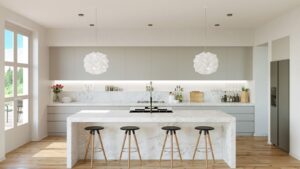
Flat roofing has become increasingly popular in modern architecture, providing a sleek and contemporary aesthetic to buildings. However, like any Texas Roofing system, it comes with its own set of advantages and disadvantages that should be carefully considered before deciding.
Flat roofing, as the name suggests, is a type of Texas Roofing system with a minimal slope or pitch, often nearly level. It deviates from the traditional sloped roofs commonly found in residential buildings. Modern architectural designs often incorporate flat roofing for its clean lines and versatility. From commercial spaces to residential homes, flat roofs have become a symbol of contemporary design.
1. Advantages of Flat Roofing
Cost-Effectiveness
One of the significant advantages of flat roofing is its cost-effectiveness. The construction and materials used in flat roofing are generally more affordable than traditional sloped roofs.
Accessibility and Space Utilization
Flat roofs provide easy accessibility, making maintenance tasks more straightforward. Additionally, the flat surface creates additional usable space, perfect for rooftop gardens, solar panels, or recreational areas.
Energy Efficiency
Flat roofs offer excellent potential for energy efficiency. They provide a platform for the installation of solar panels, helping to harness solar energy and reduce electricity costs.
2. Disadvantages of Flat Roofing
Drainage Issues
One of the primary concerns with flat roofing is drainage. Without a proper slope, water can accumulate, leading to leaks and structural damage. Adequate drainage systems must be in place to prevent these issues.
Maintenance Challenges
Flat roofs require regular maintenance to address potential issues promptly. Accumulated debris, ponding water, and wear and tear should be monitored and addressed to ensure the longevity of the roofing system.
Limited Insulation
Compared to sloped roofs, flat roofs may have limited space for insulation. Proper insulation is crucial for energy efficiency and climate control within a building.

3. Material Options for Flat Roofing
Built-Up Roofing (BUR)
Built-up roofing involves layers of bitumen and reinforcing fabrics. It’s a traditional and durable option.
Single-Ply Membranes
These are synthetic materials that offer flexibility and resistance to UV rays, making them suitable for flat roofs.
Modified Bitumen
Modified bitumen consists of asphalt with modifiers, enhancing its performance and durability.
Green Roofing
Green roofing involves the installation of vegetation on the roof, providing insulation and environmental benefits.
4. Factors to Consider Before Choosing Flat Roofing
Climate
The local climate plays a significant role in determining the suitability of flat roofing. Areas with heavy rainfall may pose more challenges.
Building Structure
The design and structure of the building must align with the requirements of flat roofing.
Budget
Consider the upfront and long-term costs associated with the chosen flat roofing system.




